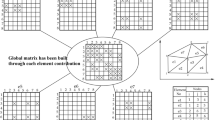Abstract
In this article, the finite element solution of quasi-three-dimensional (quasi-3-D) groundwater flow was mathematically analyzed. The research shows that the spurious oscillation solution to the Finite Element Model (FEM) is the results choosing the small time step Δt or the large element size L and using the non-diagonal storage matrix. The mechanism for this phenomenon is explained by the negative weighting factor of implicit part in the discretized equations. To avoid spurious oscillation solution, the criteria on the selection of Δt and L for quasi-3-D groundwater flow simulations were identified. An application example of quasi-3-D groundwater flow simulation was presented to verify the criteria. The results indicate that temporal discretization scale has significant impact on the spurious oscillations in the finite-element solutions, and the spurious oscillations can be avoided in solving practical quasi-3-D groundwater flow problems if the criteria are satisfied
Similar content being viewed by others
References
ANDERSON M. P. and WOESSNER W. W. Applied groundwater modeling simulation of flow and advection transport [M]. Tokyo, Japan: Kyoritsu Shuppan Co., Ltd., 1994, 118–120 (Japanese translation).
BREDEHOEFT J. D. and PINDER G. F. Digital analysis of areal flow in multiaquifer groundwater systems: A quasi-three dimensional model [J]. Water Resour. Res., 1970, 6(3): 883–889.
FUJII H. Some remarks on finite element analysis of time-dependent field problems, in theory and practice in finite element structure analysis [M]. Tokyo, Japan: University of Tokyo Press, 1973, 91–106.
NEUMAN S. P. and NARASHIMHAN T. N. Mixed explicit-implicit iterative finite element scheme for diffusion-type problems: I. Theory [J]. Int. J. for Num. Methods in Eng., 1977, 11(2): 309–323.
ZHANG Hong-ren. The abnormal problem for 2D groundwater simulation [J]. J. Hydro. Geo., and Eng. Geo., 1992, 5(1): 22–24 (in Chinese).
WOOD W. L. A note on how to avoid spurious oscillation in the finite element solution of the unsaturated flow equation [J]. J. Hydrol., 1996, 176(1): 205–218.
CHEN Z., EWING R. E. Stability and convergence of a finite element method for reactive transport in groundwater [J]. SIAM Journal of Numerical Analysis, 1997, 34(3): 881–904.
MADDOCK III T. Nonlinear technological functions for aquifers whose transmissivities vary with drawdown [J]. Water Resour. Res., 1974, 10(4): 877–881.
MADDOCK III T. Drawdown, velocity, storage, and capture response functions for multi-aquifer systems [J]. Water Resour. Res., 1991, 27(11): 2885–2898.
FUJINAWA K. Finite element analysis of groundwater flow in multiaquifer systems: 1. The behavior of hydrological properties in an aquitard while being pumped [J], J. Hydrol. 1977, 33(1): 59–72.
FUJINAWA K. Finite element analysis of groundwater flow in multi-aquifer systems: 2. A quasi three-dimensional flow model [J]. J.Hydrol., 1977, 33(2): 349–362.
FUJISAKI K., OKA H. and KAMATA A. A Galerkin finite element analysis of unsteady groundwater flow by a quasi-three dimensional multiaquifer model and a three dimensional model [J]. Earth Science of Japan, 1979, 33(2): 73–84 (in Japanese).
ZHANG X. W., TAKEUCHI K. and ISHIDAIRA H. Study on the spurious oscillation and stability in quasi three-dimensional groundwater simulation using FEM and comparison with SFEM and TFDM [J]. J. Japan Soci. Hydro. Water Resour., 2001, 14(7): 351–363 (in Japanese).
Author information
Authors and Affiliations
Corresponding author
Additional information
Biography: ZHANG Xiang-wei (1965-),Male, Ph. D., Professor
Rights and permissions
About this article
Cite this article
Zhang, Xw., Takeuchi, K. & Chen, J. Temporal and Spatial Discretization on Quasi-3-D Groundwater Finite Element Modelling to Avoid Spurious Oscillation. J Hydrodyn 19, 68–77 (2007). https://doi.org/10.1016/S1001-6058(07)60030-4
Received:
Revised:
Published:
Issue Date:
DOI: https://doi.org/10.1016/S1001-6058(07)60030-4



